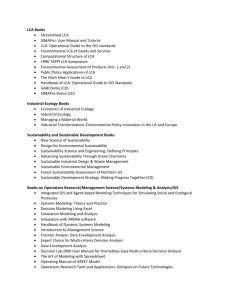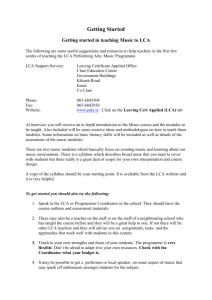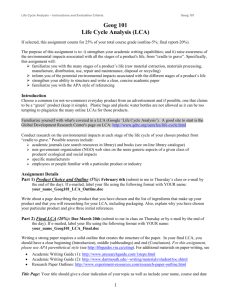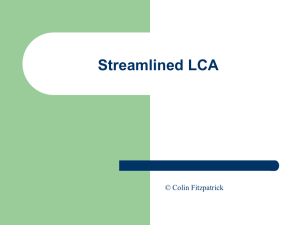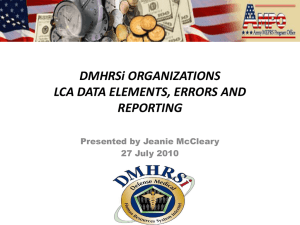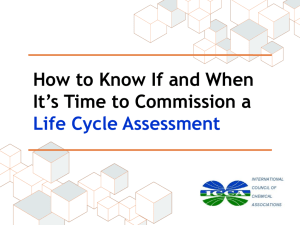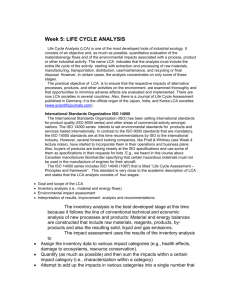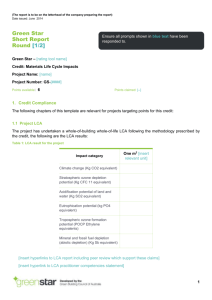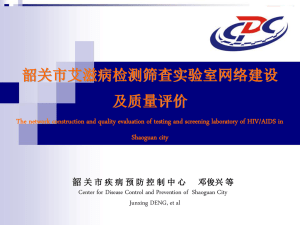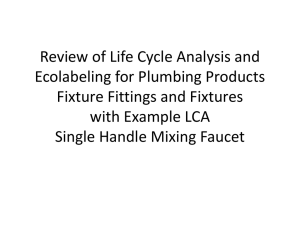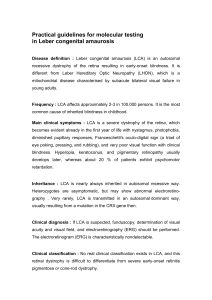Life Cycle Assessment - GoGreen Conference New York
advertisement
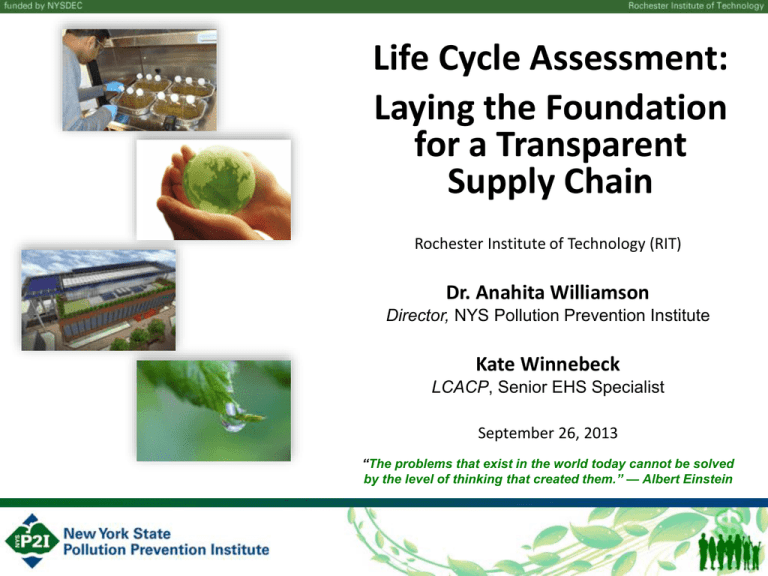
Life Cycle Assessment: Laying the Foundation for a Transparent Supply Chain Rochester Institute of Technology (RIT) Dr. Anahita Williamson Director, NYS Pollution Prevention Institute Kate Winnebeck LCACP, Senior EHS Specialist September 26, 2013 “The problems that exist in the world today cannot be solved by the level of thinking that created them.” — Albert Einstein Life Cycle Assessment Life Cycle Assessment (LCA) is a technique used to quantify the environmental impact of a product from raw material acquisition through end of life disposition (cradle-to-grave) Material Extraction Processing Component Fabrication Product Assembly Packaging & Distribution Use End of Use Processing Reuse Remanufacture Recycle Waste Treatment LCA Methodology • A Life Cycle Assessment is carried out in four distinct phases: (ISO 14040, 14044) – Step 1: Goal definition and scoping. Identify the LCA's purpose, the products of the study, and determine the boundaries. (what is and is not included in the study) – Step 2: Life-cycle inventory. Quantify the energy and raw material inputs and environmental releases associated with each life cycle phase. – Step 3: Impact analysis. Assess the impacts on human health and the environment. – Step 4: Report results. Evaluate opportunities to reduce energy, material inputs, or environmental impacts at each stage of the product life-cycle. LCA Standards • ISO 14040 & 14044 – Internationally accepted standards for performing LCA – Includes guidance for inventory collection, performing the impact assessment, interpreting results, reporting, and peer reviews – Additional requirements for comparative assessments intended to be disclosed to the public • Life cycle assessment certified professional (LCACP) – US certification program – Administered by the American Center for Life Cycle Assessment in accordance with ISO 17024 – For more information, visit www.lcacenter.org Why use LCA? • Quantify environmental benefits of products • Provide credible evidence for marketing claims • Identify opportunities to improve the environmental performance of products at various points in their life cycle • Inform decision-makers in industry, government or nongovernmental organizations • Select relevant indicators of environmental performance, including measurement techniques • Validate product marketing claims • Instill life cycle thinking within businesses LCA to Support Product Design & Marketing at Welch Allyn Compare the energy and environmental impact of three disposable blood pressure cuffs used in a single patient use model, manufactured by Welch Allyn, in order to: 1.Leverage environmentally friendly designs to increase revenue and competitiveness 2.Understand the relative contribution of each life cycle stage to the total environmental impact 3.Understand how product design decisions influence environmental impact 4.Determine the optimal end of life option for each cuff LCA Results Compare high level impact of the 3 cuffs Understand impact of individual cuff parts Compare specific points of impact of the 3 cuffs Understand process contribution to impact Understand how different EOL management strategies affect impact 8 Benefits of LCA • Results used internally to understand & improve env. impact of the cuffs – Validate dematerialization and material choices made by product designers – Understand the influence of Welch Allyn manufacturing operations and finished cuff packaging on the life cycle – Identify operations throughout the life cycle that contribute significant impact which allows the design team to focus on those processes to further reduce the impact of future designs • Results used externally to communicate env. impact of the cuffs – Validate & support environmental claims made by Welch Allyn – Educate & assist customers in making more informed purchasing and end of life management decisions • Additional benefits – Educate internal employees and engage other departments and processes that were not involved in the LCA – Through the inventory collection, Welch Allyn realized those suppliers dedicated to working with them to collect data and those that are not LCA Recommendations • Educate and rally team to understand LCA as a tool and reasons for its use • Clearly define the goal & scope of the LCA • Ensure the functional unit is clearly defined • Build the LCA model with best data physically available • Complete sensitivity analysis • Use experienced and trained LCA practitioners • Follow the ISO 14040 process to validate marketing claims and bring recognition to the study • Stay up to date on LCA research, data sources, and modeling techniques; Understand Challenges Questions & Discussion Anahita Williamson, PhD Director Email: anahita.williamson@rit.edu Phone: 585-475-4561 Kate Winnebeck, LCACP Sr. Environmental Health & Safety Specialist Email: kate.winnebeck@rit.edu Phone: 585-475-5390 New York State Pollution Prevention Institute http://www.nysp2i.rit.edu
